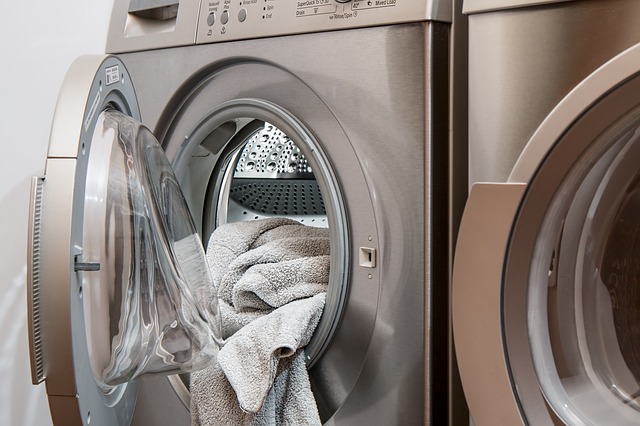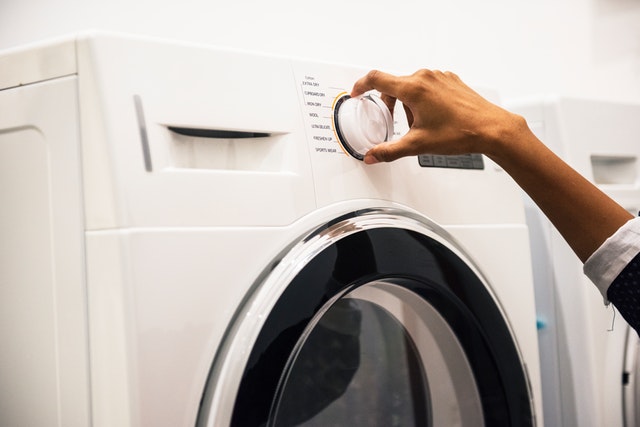Your washer and dryer are two of the most important appliances in your home — not just because they perform the vital functions of keeping your clothes clean and dry but because they draw a significant amount of resources (energy and water) and require proper maintenance to operate efficiently.
If you aren’t giving your washer and dryer any TLC, here are a few DIY tips for keeping them in tip-top shape.
Cleaning
Your washer cleans your clothes — but have you ever cleaned your washer? Over time, all the grime from your clothes as well as built-up soap scum can lower the efficiency of the washing machine, causing elements to get clogged up or stuck and your clothes to stay dirty.
Worse, because washers deal with clothing soiled by food and human waste, and because tend to stay relatively humid and moist, washing machines can become breeding grounds for dangerous bacteria like salmonella and E. Coli.
That’s why you need to be diligent about cleaning your washing machine at least every six months. Here’s a quick how-to for front- and top-loaders:
Front-loading Cleaning Steps
- Spray white vinegar on the gasket (the rubber that seals the lid) and wipe off any air, scum and mildew with a microfiber cloth.
- Add two cups of white vinegar to the detergent dispenser.
- Set the washer to the highest level and hottest water temperature, then run a complete cycle.
- Add a half-cup of baking soda to the drum, and run another cycle at the highest level and hottest water temperature.
- Wipe down the inside of the drum with a damp microfiber cloth
Top-loading Cleaning Steps
- Add four cups of white vinegar to the wash cycle.
- Set the washer to the highest level and hottest temperature, then pause the machine just after the cycle starts.
- Wipe down the top and sides of the washer using a cloth dipped in the hot vinegar-water inside the drum.
- Use a toothbrush to scrub the fabric softener and bleach dispensers.
- Continue the wash cycle after one hour.
- Add one cup of baking soda, and run another wash cycle.
- Wipe down the inside of the drum with a microfiber cloth.
Your dryer also needs a regular cleaning to prevent the build-up of lint, which is a common cause of house fires. Here are a few tips for getting your dryer clean like-new:
- Wash the lint trap. You should clean the lint trap after every load, but once every few months you should wash the trap with soap and water.
- Remove sticky messes. You can scrub off stuck-on gunk by rubbing warm olive oil on them and scraping them with the edge of a spatula.
- Clean the hose. You should remove the vent tubing from the back of the dryer and pull out any lint you find there. If there’s a ton of build-up, it might be more time-efficient to replace the tube.

Repairing
As complex machines, washers and dryers can and do break. Sometimes the fix is as easy as waiting a few hours (for the motor to cool off) or cleaning out the machine (to loosen any jams or blockages).
Vibrating or shaking washers and dryers can also often be swiftly repaired by ensuring the machine is balanced. Still, it isn’t usually easy to repair a broken washing machine.
Most often even simple repairs require special tools for taking the appliance apart and installing new components. Unless you are especially handy, you would likely be better to outsource repairing your washer and dryer to professionals.

Maintaining
Aside from cleaning every six months, there are a few tasks you need to put on your household chore schedule to ensure your washer and dryer stays functional into the future.
Here are some tricks for ensuring the health of your appliances, so you can be guaranteed clean clothes:
- Don’t overload your washer or dryer.
Doing so will put extra stress on the more delicate components around the drum, and it won’t effectively clean or dry your clothing. - Don’t run your washer or dryer without supervision.
While it might seem to save time, running your washer or dryer while you are away or asleep is a good way to court catastrophe. Floods and fires are commonly caused by these appliances, so you need to remain vigilant - Don’t store items on or around your washer or dryer. Both appliances need room to move and breathe; overheating is a common issue that degrades the machines. Plus, items nearby can be damaged by the machines’ movement or by water or fire.
- Don’t add materials not permitted by the manufacturer’s instructions. Manufacturers commonly caution against washing items covered in gasoline, cooking oil or paint. You should also avoid using detergents not sanctioned by the manufacturer.
You need your washer and dryer, but your washer and dryer need you, too. Treat your appliances well, and you won’t have to worry about whether they’ll function like you expect.




